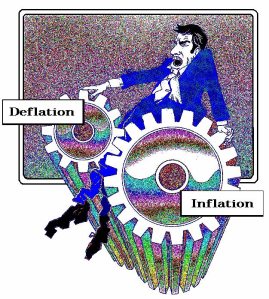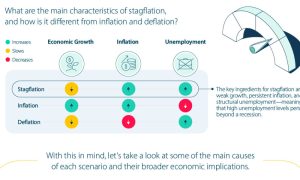May 31, 2024 | Deflation v Inflation v Stagflation – Misconceptions Clarified

Some people have a very hard time understanding that we are in a massive deflationary spiral; they think that rising prices simply means it is inflation and not deflation. Then they mistake stagflation for deflation and wonder why people are spending more on less. They only see prices, not disposable income, and certainly not economic growth and unemployment.
Prices rose sharply following the OPEC oil price hikes of the 1970s, but the sharp rise in energy crowded out other forms of spending, resulting in rising prices that had nothing to do with a speculative economic expansion but a deflationary contraction they called STAGFLATION occurred with rising prices and declining economic growth.
This is like Biden saying vaguely that he will press corporations to raise wages and lower prices. Great plan, which, as always, means absolutely nothing and illustrates that he has nothing to offer. Biden revealed his position that government is never the problem. If you want to raise NET DISPOSABLE INCOME, lower taxes! Raising wages, as he argues corporations should do, will escalate people to higher tax brackets, and soon, all benefits will come into play with these socialistic programs. As always, nobody in government ever talks about reducing the size of government waste and corruption.
Household income will soon be defined as everyone living in the same house – kids and all. Perhaps you will have to pitch a tent and make the kids sleep outside with the dog to avoid “household” income tax increases. Deflation is not the lowering of prices, it is the lowering of economic activity that can also include STAGFLATION, which occurs when prices rise but there is no economic growth.
Now, stagflation is not exactly the same as deflation, where the price of goods and services do decline. For example, prior to World War II, the US experienced a massive deflationary environment where GDP fell 30% between the crash of 1929 and 1933. A quarter of Americans were unemployed. Prices plummeted, and consumers were not spending because they had very little, if anything, to spend. Panics erupted, and people hoarded; the Second World War brought America out of that economic downfall.
During periods of stagflation, the prices of goods and services increase while buying power decreases. Consumers end up spending more on less. As we are seeing now, for example, retail sales on items such as clothing have declined, but people are spending more on gas and groceries. People feel as if they are earning less despite earning more because their buying power has been drastically reduced. Companies will suffer as consumers spend less, as we are seeing at restaurants, as one example, and this will lead to reductions in the workforce. Unemployment during the OPEC crisis of the 1970s was not nearly as drastic but unemployment did rise to 7.2% by 1980. Inflation went from around 1% in 1964 to 14% in 1980, and GDP growth went from 5.8% to -0.3% during that same period.
So be very careful. If you only look at prices rising and ignore the fact that your disposable income is declining, you will be in for a very rude awakening.
STAY INFORMED! Receive our Weekly Recap of thought provoking articles, podcasts, and radio delivered to your inbox for FREE! Sign up here for the HoweStreet.com Weekly Recap.
Martin Armstrong May 31st, 2024
Posted In: Armstrong Economics













